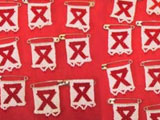Fragile Optimism on the HIV/AIDS Front
By Sara Kuepfer Thakkar for ISN
Over 20,000 HIV professionalsexternal pagewill gather in Viennacall_made on Sunday for the World Aids Conference (18 - 23 July) to discuss the major issues facing the global response to HIV. Ahead of the conference, UNAIDS released a new external pageOutlook reportcall_made, which documents some hopeful developments.
HIV prevalence among people aged 15-24 reportedly has declined by over 25 percent in 12 of the worst-affected countries, mostly due to declining HIV infection rates among young people. UNAIDS believes this progress is due to a change in young people's sexual behavior.
In an interview with the Guardian earlier this week, UNAIDS director Michel Sidibe external pagesaidcall_made we are currently "at a defining moment" in the fight against HIV/AIDS, and that the global AIDS response now needs to be adjusted to new circumstances – the global economic crisis and the rising costs of antiretroviral drugs.
As HIV becomes resistant to drugs over time, patients currently on treatment are eventually required to move on to second-line drugs, which are newer and more expensive. The high cost of these new drugs makes it very difficult for governments to maintain their treatment programs, especially at a time of declining tax revenues and austerity measures.
Patients treated with antiretroviral drugs, which lower the level of the virus in the body, are less likely to pass on HIV; hence, increased access to these drugs is expected to lead to a dramatic reduction in new HIV infections. UNAIDS talks about the potential of averting an additional 10 million deaths by 2025.
The new HIV/AIDS strategy championed by Sidibe, dubbed Treatment 2.0, emphasizes the more cost-effective administration of both first- and second-line antiretroviral drugs. As a data analyst consultant with UNAIDS tells ISN Security Watch, reducing the production, delivery and monitoring costs of both drug treatment regimes and increasing coverage will be the ultimate goal – a goal she thinks can be achieved with the necessary political will.
Yet today's reality still looks grim. external pageLess than halfcall_made of the 9.5 million people around the world who currently require antiretroviral treatment actually receive it. And as treatment prolongs the life of patients, the number of patients requiring treatment will inevitably rise. Hence, the stagnation or reduction in funding for HIV/AIDS treatment will mean that new patients requiring treatment will have to be turned away, resulting in the reversal of recent progress on the HIV/AIDS front.
Hit by last year's economic recession, wealthy donor countries such as the US have announced reductions in their contributions to the external pageGlobal Fund to Fight AIDS, Tuberculosis and Malariacall_made. In addition, last year's economic crisis pushed millions of people below the poverty line – among them also HIV/AIDS patients no longer able to pay for treatment out of their own pocket.
Yet blame cannot solely be placed on wealthy donor countries. Uganda, for example, with an estimated 1.1 million people living with HIV, reportedly has the internal fiscal capacity to increase access to antiretrovirals for its citizens but seems to lack the political will to do so. Also India has been accused of failing to ratchet up government funding for treatment.
Ultimately, it is becoming more of a question of political will in both developed and developing countries as to whether the 2015 universal access target will be reached. 'AIDS fatigue,' rather than shrinking government coffers, may prove to become the biggest hurdle to progress on the global HIV/AIDS front.

